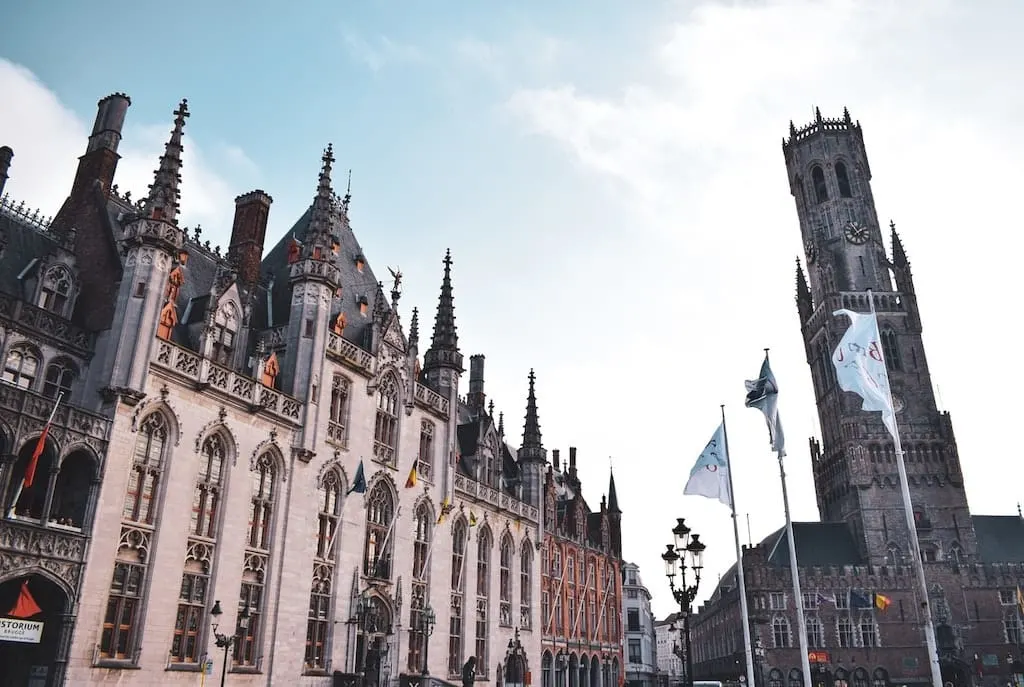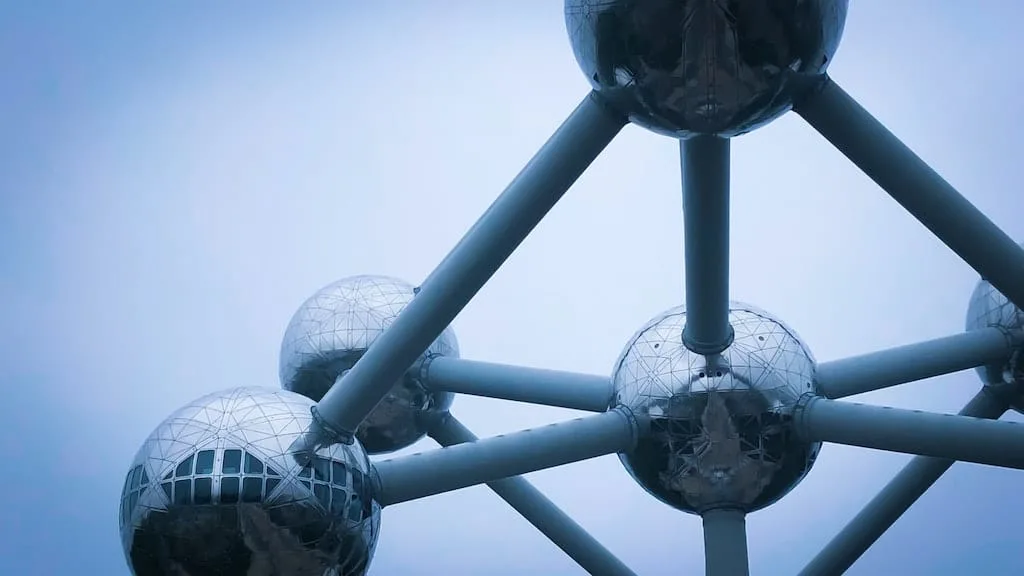Expert travel storyteller Jordan Adkins, founder of InspiredByMaps.com, brings a decade of adventures across 101 countries and 450+ UNESCO sites into rich, off-the-beaten-path narratives, melding ecological expertise with genuine, seasoned travel insights. His full bio can be found here.
Belgium is one of the most fascinating travel destinations in the world, an intertwined mess of historical and contemporary excitement from Brugges’ history-soaked streets and Brussels Northern Quarter urban jungle to the medieval Belfry of Ghent and Liège’s modern railway station.
There’s so much to see here but exploring Belgium’s most iconic landmarks is a perfect place to start …
There are beautiful cities, architectural landmarks, touching tales, small towns, stately homes, parks, farms, art and design, exhibitions, and lots of customs and rituals. As you would expect in a proud nation with a long and storied history.
It is easy to forget that this Western European country also has some beautiful scenery with a wind-swept coastline, lakes, forests, and flower fields. Of course, you probably are not heading here for an eco-escape like New Zealand or Nepal, but it’s nice to know the options are there.
In Belgium there’s just so much to visit; you might spend a lifetime exploring here and only just begin to scratch the surface. That’s why we created this cheat sheet to support you on your journeys. Many of them are featured in films set in Belgium and you might recognize them already.
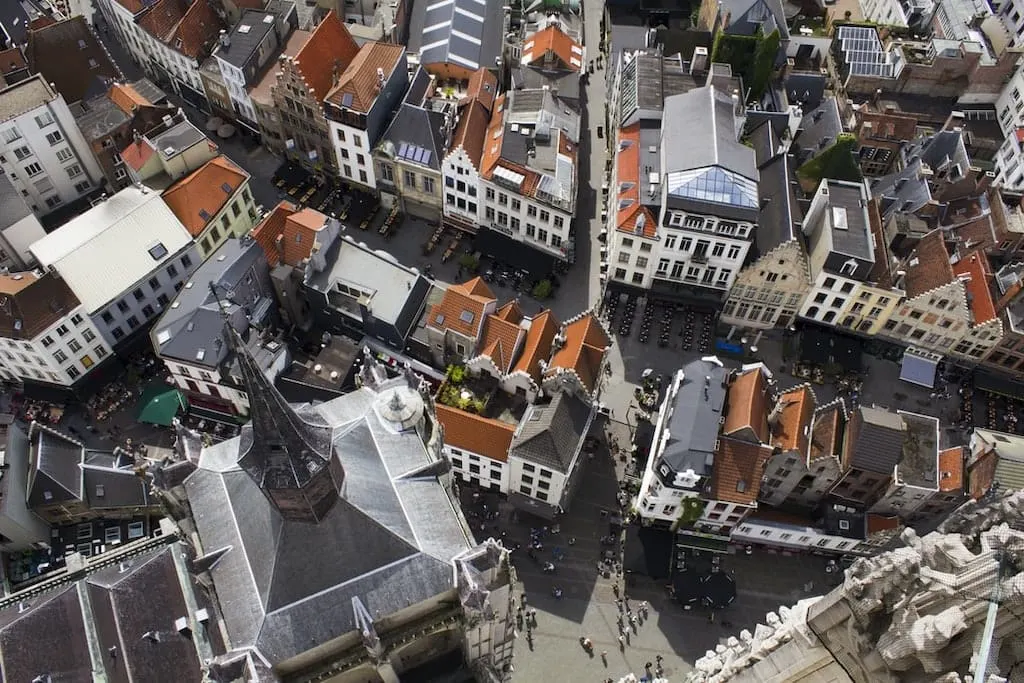
But first – what is a landmark?
A landmark is a distinctive natural or artificial attribute that usually stands out from its surroundings and has become an emblem of local or national character. A landmark is helpful for urban visitors to travel-both in terms of being a tangible waypoint and in trying to assist you in coordinating your itinerary.
Getting off the beaten track is all well and good, but at the end of the day, there are some places you just need to see when you visit a country. Immediately recognizable places that you couldn’t miss if you tried – like the Sydney Opera House or the Miami beachfront. And Belgium has more than just its fair share …
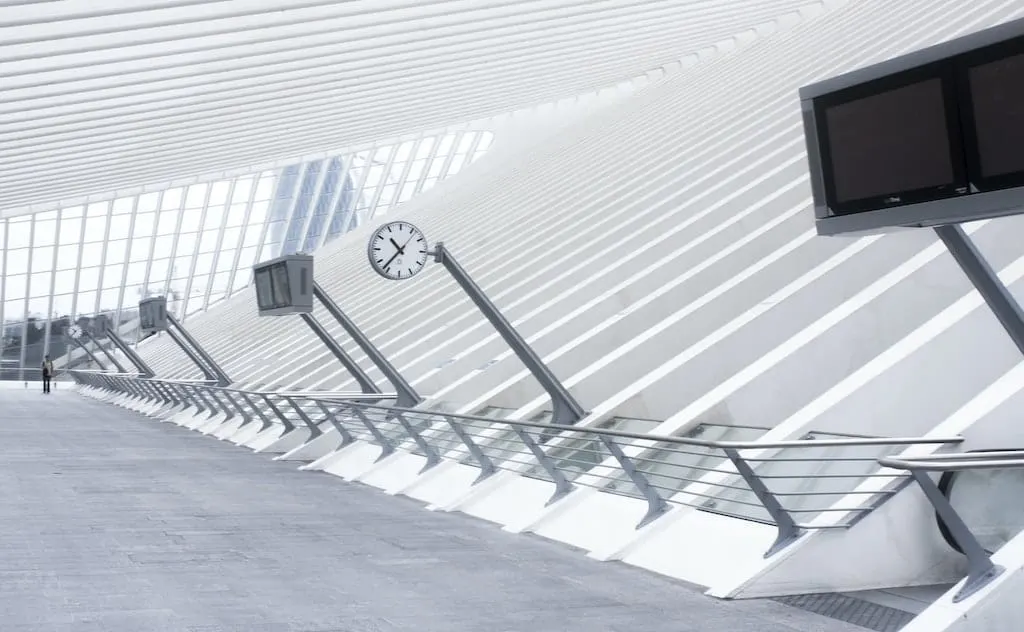
When approaching a trip to the land of chocolate, waffles, fries, and beer, you will want to tick off as many famous Belgian landmarks as you can – and the best way is to do that is often by renting a car, taking a tour, or using the Eurail Pass to get around.
There is a lot to explore in Belgium — and no list of famous Belgian landmarks can ever be exhaustive. But, we’ve tried to get the best bits by calling out to our favorite travel bloggers and asking them to give us tales and helpful tips about their best-loved ones.
This way, you have an appropriate frame of reference to motivate your journeys to Belgium, from which you can select a few landmarks that you truly can not miss … Or shoehorn in as many of them as feasible on a single trip.
If you plan your Belgian trip right — and you’ve got enough time — you could just hit them all. This is a small country after all. And discover a great deal more of your own highlights of Belgium while you’re at it!

Page Contents
- Antwerpen-Centraal Railway Station
- Basilica Of The Holy Blood
- Belfry Of Bruges
- Belfry Of Ghent
- Church Of Our Lady Bruges
- Espace Léopold / European Parliament Building
- Gravensteen
- Grand-Place Of Brussels
- Haverwerf In Mechelen
- Historical Leuven Town Hall
- Lion’s Mound
- Liège-Guillemins Railway Station
- Mannekin Pis
- Menin Gate
- National Basilica Of The Sacred Heart
- Saint Nicholas Church
- St Michael And St Gudula Cathedral
- Stoclet House
- The Atomium
- The Markt Of Bruges
Antwerpen-Centraal Railway Station
Antwerp Central train station, also known as Middenstatie (Middle station), is not only one of the most beautiful train stations in the world, but also one of the most famous landmarks in Belgium.
A joy to walk around, adding to the pleasure of travel, the station is considered by many as one of the finest examples of 19th-century architecture. Inspired by Lucerne Station and built at the request of King Leopold II to replace the old wooden train station, construction took place from 1895 to 1905. Designed by Louis de la Censerie, its lavish construction of marble and stone makes it look like a cathedral. A masterpiece of railway architecture, it features a 75-meter-tall dome and eight smaller towers.
The sheer size and grandeur are stunning, with trains arriving and departing on three levels under a huge iron and glass vaulted ceiling covering the platforms. The station’s opulence permeates the power and clout once bestowed on Antwerp.
The imposing station is located on De Keyserlei, home to several gold and diamond shops, and is an important hub, connecting cities like Amsterdam and Paris on the high-speed Thalys. The magnificent station hall features a palatial staircase leading to the train shed, the heart of the station. The staircase below the semi-circular glass panel with marble, stone, and gilding make any photo an instaworthy shot. A gilded coat of arms and clock adorn the glass panels, also known as the peacock trail, make it a stunning work of art.
This is more than a train station and is a tourist destination in its own right. This railway cathedral should be on your must-do list so you can see how old-world architecture works so well in today’s modern world. The high-speed trains arrive and depart some 20 meters below the ground, and yet the natural light and grandeur as you head up the escalators is abundant throughout every part of the multi-level station.
Whether you are train spotting, people watching, or eating or drinking in one of the many cafes and fast food chains; this station has a fascinating and grandiose life and rhythm of its own that should not be missed.
Explored by Lyn Baker from A Hole In My Shoe
![]()
Basilica Of The Holy Blood
When traveling through Belgium, a visit to the beautiful city of Bruges is a must, and while there, it should be one of your top priorities to pay a visit to the iconic Basilica of the Holy Blood. With a unique combination of Romanesque and Gothic architecture, this Roman Catholic minor basilica is one of the city’s most famous landmarks.
It consists of two chapels, one dedicated to St. Basil the Great and built in Romanesque style and the other one to the Holy Blood, primarily in Gothic style. The basilica is of great significance to pilgrims because of its relic of St. Basil and, even more importantly, its relic of the Precious Blood, a cloth that is said to have the blood of Jesus on it. Thanks to this important relic, which is displayed in a shrine inside the cathedral throughout the rest of the year, the people of Bruges celebrate an annual century-old procession around Easter.
This religious event is so unique and central to the city of Bruges that it was declared UNESCO World Heritage.
Thanks to its central location in Bruges’ famous Burg Square, the Basilica of the Holy Blood is very easy to visit. As soon as you approach the church, you will be greeted by the glowing golden statues near the entrance that create a stark contrast to the dark grey rest of the building. Since the basilica is an important place of worship for Catholics, there is no entrance fee.
However, you will have to pay 2.50 euros to enter the treasury museum that houses the relic of the Precious Blood. While paying money to enter can be quite off-putting to some travelers, especially those on a tight budget, I absolutely recommend paying the small fee to see this famous historical relic that so many worshippers travel to Bruges for.
Explored by Arabela from The Spicy Travel Girl
![]()
Belfry Of Bruges
Bruges Belfry tower (Bruges Belfort) is one of the unmistakable landmarks of Belgium and the centuries-old symbol of the city of Bruges. The history of this impressive tower dates back to the beginning of the 13th century! However, the tower had quite a turbulent history and has been damaged and restored many times. Its current look dates from the early 19th century. Bruges Belfry is a protected monument listed as the UNESCO World Heritage Site.
You can’t miss this tower when in Bruges – the Belfry is located right at the central Market Square. The entrance can be found at the backside of the tower. While most people choose to simply admire the impressive town square and the tower from the outside, you can actually visit the Belfry tower and go all the way to the top.
Your effort to climb the 366 steps on a narrow staircase will be rewarded with great panoramic views of the city and its surroundings. In addition, inside the tower, you can see some historical artifacts from the days when the Belfry served as a municipal archive and city treasury. And, of course, there are huge bells that ring every 15 minutes. Quite an impressive sound, especially if you happen to be right at the top of the tower when it happens.
Bruges Belfry is open daily except for some bank holidays. Count 30-45 minutes for your visit, not including the queuing times. Here you can find more information about your visit to the Belfry of Bruges.
Explored by Jurga from Full Suitcase
![]()
Belfry Of Ghent
Enchanting Ghent is home to many Belgian landmarks, but the Ghent Belfry, part of the UNESCO designated “Belfries of Belgium and France”, must be the most intriguing one.
This iconic structure has been around since the 14th century and makes up an integral part of the city’s history. Apart from its religious function, it has also served as the local watchtower. Ghentians were so fond of their Belfry that they named the alarm bell Roland. When Roland was melted into a carillon in the 17th century, the largest new bell was named after the original one. In the 20th century, Roland II cracked. Ghent’s favorite bell was saved and has been on display right next to the Belfry ever since.
Another fascinating fact about the Belfry is that, for centuries, the city’s privileges were kept in the Belfry’s secrecy room and guarded by the shiny golden dragon that tops the tower. Ghent’s mascot still plays a role during important celebrations, when it breathes fire. The last time this spectacle took place was during the summer of 2018, for the 175th edition of the Ghent Festival.
A must-do in Ghent is climbing the 366 steps to the tower of the Belfry. As you make your way to the top, you can have a closer look at the actual carillon and inspect the mechanical clockwork. The views from the tower are spectacular.
The Ghent Belfry is located at the very heart of the city’s pedestrian zone, across from the City Hall. Various trams and buses can take you there, and it’s also within walking distance of most hotels.
Explored by Sarah from CosmopoliClan
![]()
Church Of Our Lady Bruges
Bruges is one of the most romantic cities in Europe. It’s known for quaint Medieval style cottages, swans gliding through canals, and historical wealth and opulence. There are several important museums and historic buildings in Bruges. However, one has quite a remarkable story — the Church of Our Lady of Bruges.
The massive tower at the Church of Our Lady of Bruges is one of the largest brickwork towers in the whole world. When you are walking around Bruges, it’s hard to miss its iconic steeple.
Originally built in the 13th century, this church was the epitome of luxury and grandeur (both then and now). The facade has a distinct Gothic character with flying buttresses and check-patterned flooring. The church is quite beautiful, but it holds a sculpture that is even more famous.
Michelangelo’s Madonna and Child can be found in the Church of Our Lady of Bruges. It’s a baroque style marble sculpture of the Virgin Mary holding baby Jesus. Michelangelo completed the statue in 1504, and it wasn’t much appreciated at that time!
In fact, the sculpture was somewhat scandalous. It was one of the first works that showed Mary absentmindedly gazing away from her baby (instead of piously admiring him with wonder). Jesus sits on Mary’s lap very loosely, as if he were barely supported by her.
During Michelangelo’s life, this was his only work to every leave Italy. It was bought by wealthy coin merchants in Bruges, having gained very favorably during the ‘Golden Age.’
Explored by Valentina from Valentina’s Destinations
![]()
Espace Léopold / European Parliament Building
Brussels is full of iconic landmarks, but the ones you’ll see most often on TV are the ones in the European Quarter. This area, which is also known as the Leopold Quarter, where you’ll find the buildings of the European Union and European Commission.
The European Parliament building in Brussels opened in 1993 and holds the main offices of the MEPs (Members of the European Parliament). It’s not the official home of the Parliament (that’s in Strasbourg, 270 miles away), but three-quarters of Parliamentary business takes place here in Brussels.
The main feature of the building is the “Hemicycle” parliamentary debating chamber. The building looks a little space-age and otherworldly – from outside; it’s easy to imagine that you’ve stepped into a scene from Star Trek. Inside, the debating chamber has seats for all 705 MEPs, with a viewing gallery above.
Taking a European Parliament tour is one of the most interesting things to do in Brussels. The Hemicycle is open to the public for self-guided tours on most days during the week, apart from days when the Parliament is sitting – on those days, a limited number of visitors are allowed in to watch the debates. You don’t need to book to take a self-guided tour.
Getting to the European Parliament in Brussels and the Hemicycle is really easy, with a train station on-site and three Metro stations nearby. Nearby, you’ll find a number of other European Union-related attractions, including the Parliamentarian interactive exhibition and the House of European History museum. There are also some lovely parks. While you’re in the area, don’t miss seeing the European Commission’s Berlaymont building and the near-constant stream of TV news crews doing reports outside.
Explored by Helen from Helen on her Holidays
![]()
Gravensteen
In the center of Ghent, you’ll find Gravensteen castle, which is known as the Castle of the Counts. This impressive medieval castle made of stone with a moat surrounding it was built upon a former fortress in 1180.
The castle was intended to be both a symbol of authority as well as might to the citizens of Ghent due to its important role for the Counts of Flanders, who used the castle as a residence. After the 14th century, the counts primarily ruled from another city. After this time, it was used as a prison, a mint, and even a cotton mill around the Industrial Revolution.
Today, it’s a museum, and it’s been beautifully restored to its medieval state as much as possible. From the top of the castle, you can enjoy beautiful views of Ghent and its river. Highlights of the museum include its impressive sword collection and a hilarious tour by a local comedian with some of the darker (and lighter) moments of its history. You’ll also be able to step into the dungeons as well as the former torture chambers to learn more about the darker side of Gravensteen.
It’s hard not to miss Gravensteen’s epic towers in the distance no matter where you are in Ghent, but there’s something so magical about finding this time capsule into the past surrounded by tram lines and a modern city. Even if you have just one day in Ghent, don’t miss Gravensteen! During Christmas, the castle often hosts a Christmas market and turns one of its darker rooms into a jolly Christmas cafe.
Explored by Karen Turner from Wanderlustingk

Grand-Place Of Brussels
The Grand-Place, also called Grote Market, is one of the most famous landmarks in Belgium, and it has been a UNESCO World Heritage Site since 1998. The best way to start your Brussels Itinerary is at the Grand-Place in the heart of the city.
This magnificent main square is the main tourist attraction, and it is considered one of the most important squares in Belgium. It is completely free to explore, but you can also purchase a ticket and visit the museums and the tower. The square is a great place to hang out in one of the cozy cafes, grab a Belgian waffle while you do some people watching, or visit the famous chocolate shops. Most of the buildings are from the 17th century, but the market activities in the Grand Place square date back to the 12th century.
Allow yourself to turn 360-degrees to take in all the stunning architecture, with one side of the Grand Place dominated by the Gothic city hall, with the dramatic spire, and the opposite side the darker grey but equally ornate Maison du Roi, or King’s House, now the home of the city museum. The Grand-Place was the headquarters for Medieval Brussels’ most influential trade guilds: the brewers, the bakers, the sailors, and many others. It is also the location of many important festivals and events like the Winter Wonders Christmas Market, the Flower Carpet, Floralientime, Ommegang, and the Belgian Beer Weekend.
The Grand-Place is an iconic landmark in Belgium that has retained its charm and characteristics throughout the centuries. The Baroque and Gothic attributes, along with the amazing gold details, make it an absolute must-visit landmark in Belgium.
Explored by Paula from Paula Pins the Planet
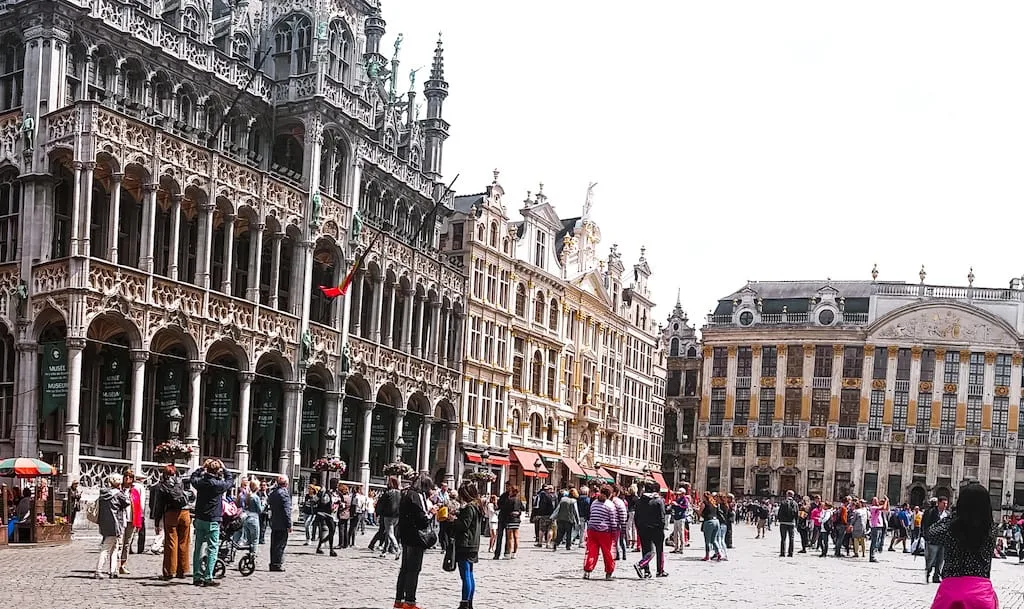
Haverwerf In Mechelen
Mechelen is a medium-sized town, conveniently located between Brussels and Antwerp and well worth spending a day visiting. The city has many beautiful places, but my personal favorite is De Haverwerf.
Haver means grain in Dutch, and this was the place where back in the day grain would be bought and sold. Nowadays, you cannot buy grain anymore, but you can visit the three colorful 16th-century houses that are planted on the shores of the river. From left to right, they are called Saint Joseph, The Devil, and Paradise. If you look carefully at their frescoes and woodcarvings, it is not hard to understand where the names are derived from.
“Saint Joseph” or the red house has a relief etched into it of the saint holding his son. The dark green wooden house or “The Devil” is one of the most beautiful wood-paneled houses of the country and received its name thanks to the little devil sculptures on the façade. Last, but certainly not least, is the light green house aptly called “Paradise.” If you look carefully, the frescoes above the window depict scenes of Paradise on Earth.
There is no possibility to visit the houses sadly as they are privately owned. Make sure you cross the river and have a look at the beautiful reflection of the houses from the other side. Do be careful of the traffic as the bridge to cross the river can get pretty busy during the day.
Explored by Caroline Muller from Veggie Wayfarer
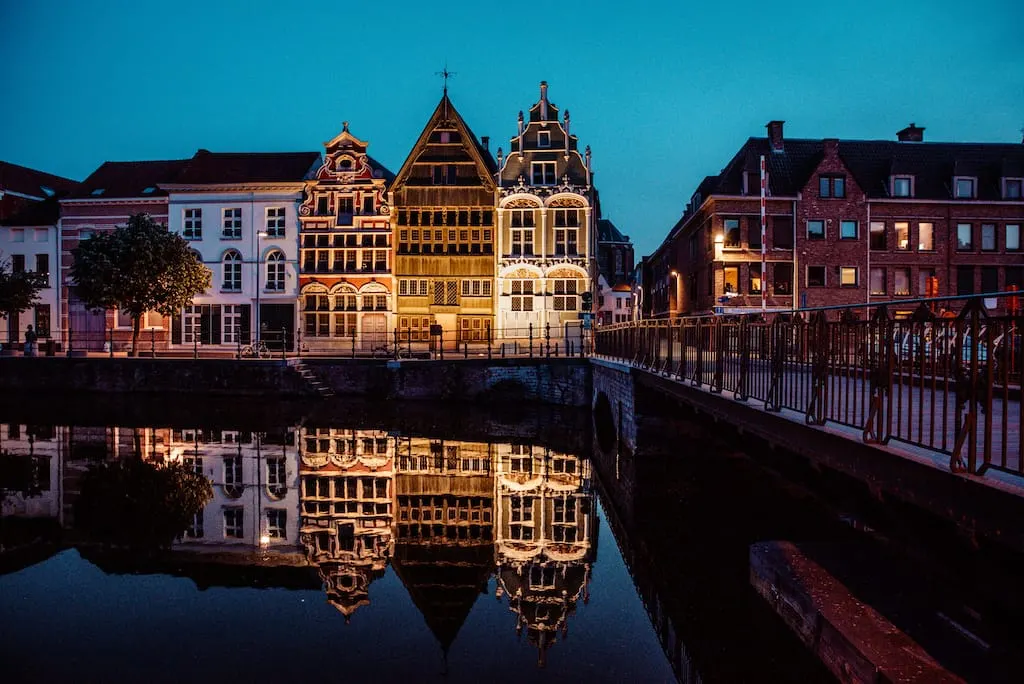
Historical Leuven Town Hall
Construction on the Leuven Town Hall commenced in 1439 after the pope at the time requested a rebuild of the previous building, but this time with far more glamour. Mission accomplished. Flamboyantly stuffed with turrets, flags, statues, and intricate engravings, the Leuven Town Hall is a baroque marvel and an iconic landmark in Belgium.
The façade is loaded with statues of local scholars, artists, noble-folk, biblical figures, and eminent citizens of the time. In all, there are 236 statues on the building, bestowing an ostentatious intrigue that stands in curious contrast from those surrounding it. Miraculously unscathed after two world wars, the Leuven Town Hall stands triumphant over newer – but also beautiful – buildings in the main square. It’s an eye-popping attraction but also a sad reminder of what Leuven may have once looked like before being so heavily damaged by war.
Inside this baroque marvel, ornate details, gilded ceilings, and lavishly furnished saloons compliment the exterior. The showpiece is the impressive Gothic Hall with its intricately carved fireplace. The portraits of all the mayors and the Lineage of Leuven – portraits of the town’s seven sons-in-law – embodies just how significant this building was to the city’s elite.
Collecting photographs of the building as the color starts to fade in the late afternoon is a beautiful way to capture the details of this impressive example of baroque architecture. While the exterior is the main drawcard, visits inside are possible on guided tours.
Leuven is easily accessible, just 20 minutes via train from Brussels.
Explored by Paul from Anywhere We Roam
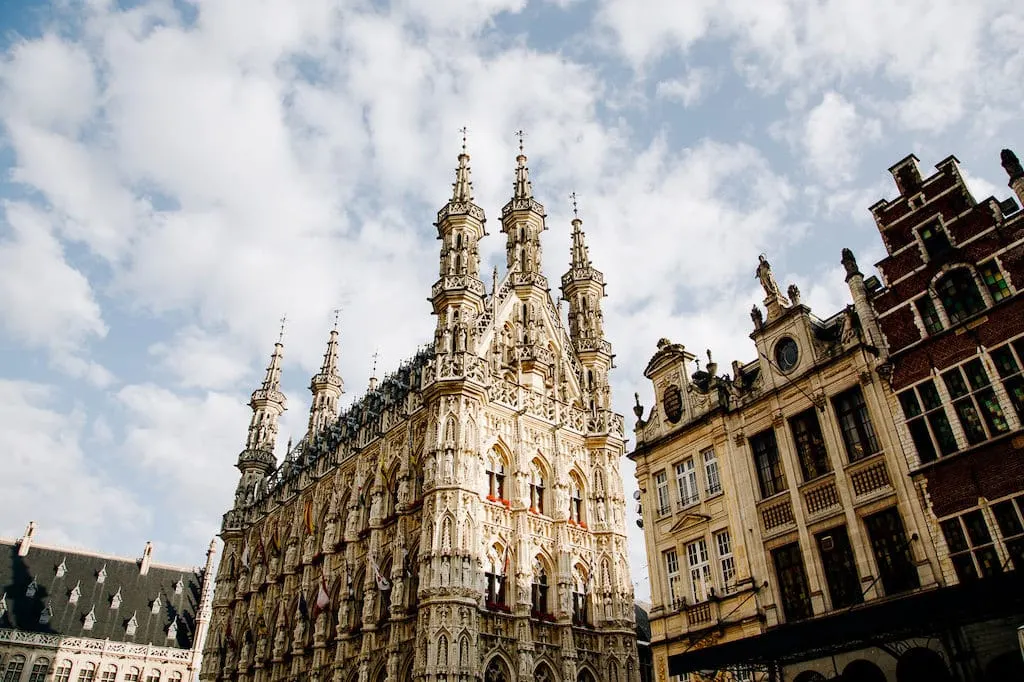
Lion’s Mound
You might know Waterloo from the award-winning Eurovision song by ABBA. However, that small town in the province of Walloon Brabant is also quite significant historically and is definitely a must-visit when you come to Belgium. It is where the 1815 Battle of Waterloo occurred, best known for the fall of Napoleon Bonaparte.
The place to go in this small town (population: 30,000) is the Lion’s Mound (Butte du Lion). It is a man-made hill built to commemorate the soldiers who were killed in the historic battle. The specific spot where the statue of the lion is located is said to be where The Prince of Orange (William II of the Netherlands) fell on the ground after he was hit by a musket ball.
The lion at the top of the mound — reachable through a 226-step concrete staircase — faces France. The mound itself was created from soil excavated from the battlefield, taking three years to complete. Guests are welcome to climb the mound and view the battlefield from the top. It is included in the entry fee of €16, including entry to the newly renovated museum as well as a visit to the nearby farm.
Aside from climbing up the mound and admiring the view, taking time to go around the museum is also highly recommended. An audio guide is available, which makes it easy to understand what is on display. Furthermore, there are also interactive exhibits that are a great hit with the kids, as well as a 4D theater to show what happened during that time.
Indeed, Belgium is more than just waffles, chocolates, and frites. It is about history, too, and the Lion’s Mound is an excellent place to appreciate it.
Explored by Aleah Taboclaon from Solitary Wanderer

Liège-Guillemins Railway Station
The Liège-Guillemins railway station is located in Liege, one of the most beautiful cities in Belgium. This station is among the largest stations of Belgium, was made by Valencian Architect Calatrava.
He is a talented and fantastic architect; we may see it in his excellent Liege station’s great work. The station is renowned, as it was the first made continental railway station, and the trains move at the highest speeds here. The station is reliable for delivering domestic as well as international services.
In 2009, this fastest railway station was constructed awfully with glasses and steel. It becomes the illustrations of a city’s renovation and tower as an entity of the town, making it iconic. People stunned by seeing the modernized and precise, transparent architecture of it. Travelers can easily reach the Liège-Guillemins railway station as ease communications are available from several places, and it doesn’t take much time. It takes around 20 min from Aachen, 30 min from Maastricht, more than 2 hours from Paris, and needs 3hr 15 min from London.
The exterior and interior construction of the station is seamlessly designed. For any observer inside the station, the station’s arches configuration provides a commanding view from the outside. An astonishing procedure was followed while creating the bridge to employ the steel frame, without interrupting the train movement. It is stunning when we see the bridge at night; it looks seven times until the arch.
Explored by Paulina from Paulina On The Road
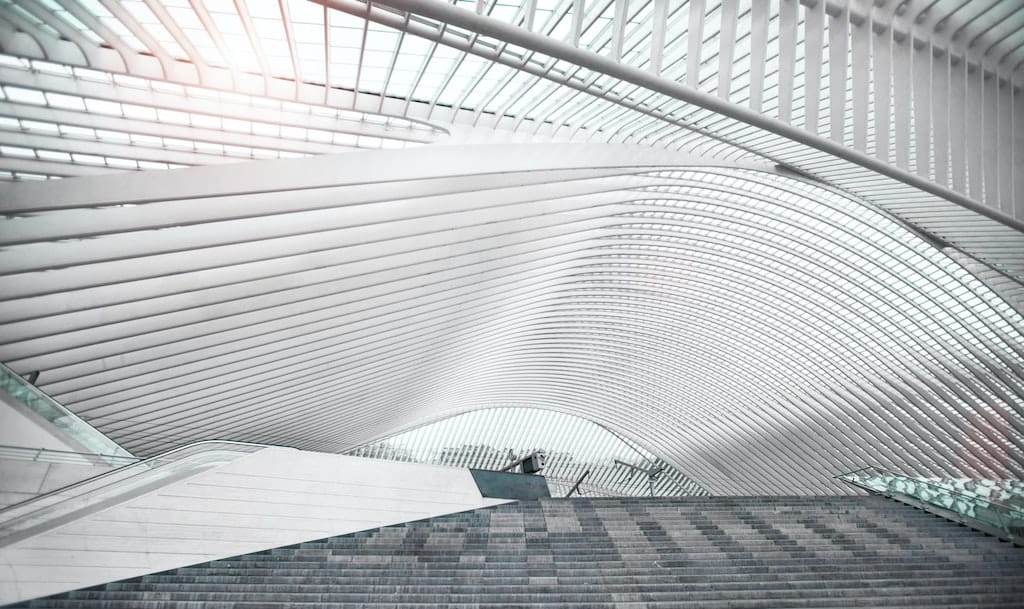
Mannekin Pis
Mannekin Pis, or the “Little Peeing Boy” in English, is a famous landmark in the capital city of Brussels. The statue is a representation of the local sense of humor and has a variety of origin stories, some bizarre, others believable, and some bizarrely believable.
The most “historical” of those origin stories is it was depicting children who used to pee on tannery to help soften the material. It quite literally depicts a small boy peeing into a fountain. It’s a lot smaller than what I had expected and is closer to life-size than the oversized statues we typically see.
The bronze statue dates back to the early 1600s, though the current statue is a replica that was created in the 1960s. It is frequently dressed up in a variety of costumes and outfits, and there is a published schedule to see when the next costume is due to be revealed. These costumes cover a wide variety – from Halloween costumes to historical costumes and even pop culture costumes as well.
Mannekin Pis is located a short distance from the Grand Place in Brussels, on the corner of Rue de l’Etuve and Rue du Chêne.
It is not the only depiction of a peeing child in the city of Brussels, for there is also a second statue – Jeanneke Pis. Jeanneke Pis is located in the alley next to the Delirium Pub in Brussels and is a short walk away from Mannekin Pis. This statue is more modern, having been created in 1985 and acts as a counterpoint to the famous Mannekin Pis.
TIP: The costumes of Mannekin Pis are held in a permanent exhibit at the City Museum, located in Grand Place, if you want a closer look at the wide variety of costumes!
Explored by Jamie from Travel-Addict.net
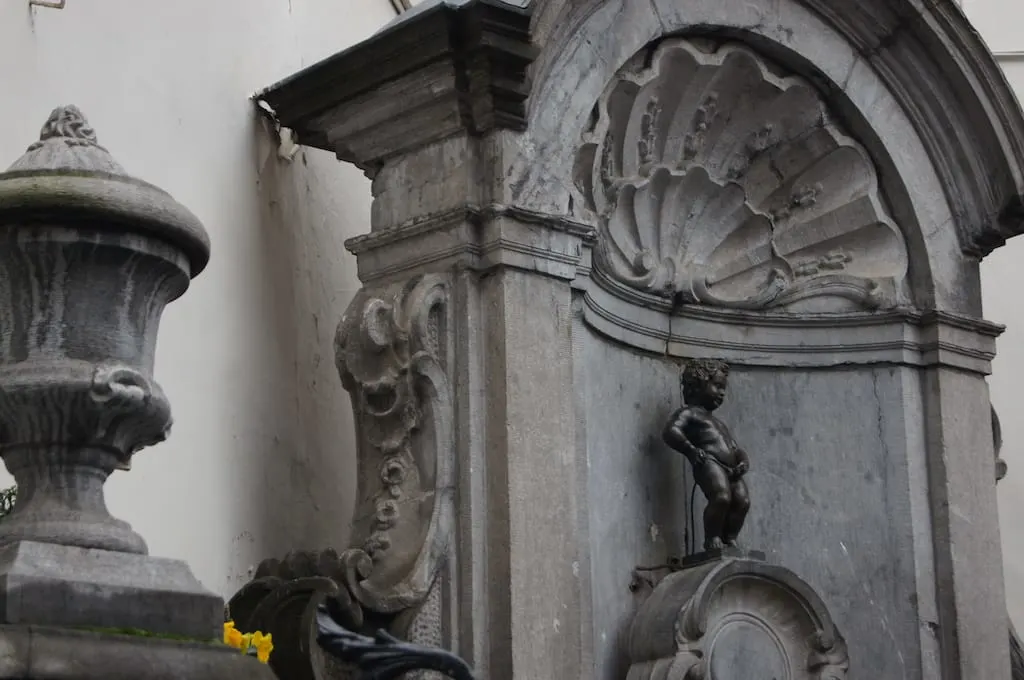
Menin Gate
In the sleepy town of Ypres, you’ll find the Menin Gate, a huge memorial to the missing soldiers of Britain and the Commonwealth in the First World War. Located in the center of the town, the Menin Gate is hard to miss and is one of the biggest tourist attractions in the city. The Commonwealth War Graves Commission chose Ypres as the site of the memorial since the majority of the fighting took place here. There were a staggering five Battles of Ypres!
The Menin Gate Memorial was unveiled way back in 1927, after the city, which had been completely destroyed during the war, had been rebuilt. Under the Menin Gate, you’ll find the names of over 54,000 missing soldiers etched into the stone. To this day, remains of soldiers thought lost in Ypres are found, and, if they are identifiable, their name is removed from the Menin Gate.
Although lots of visitors flock to the Menin Gate throughout the day, the night is the ideal time to visit. Every evening at 8 pm, buglers from the town play “the Last Post,” a bugle call that used to be played in the British Army to mark the end of the day. This is followed by a series of speeches, and sometimes a song, to pay respects to the missing soldiers. The Last Post Ceremony at the Menin Gate happens every evening of the year, including on Christmas Day, and is hugely popular with visitors to the city.
People from Commonwealth countries all over the world visit Ypres specifically to see the Menin Gate, but even those from other countries find the Menin Gate impressive and poignant.
Explored by Ella from Many More Maps
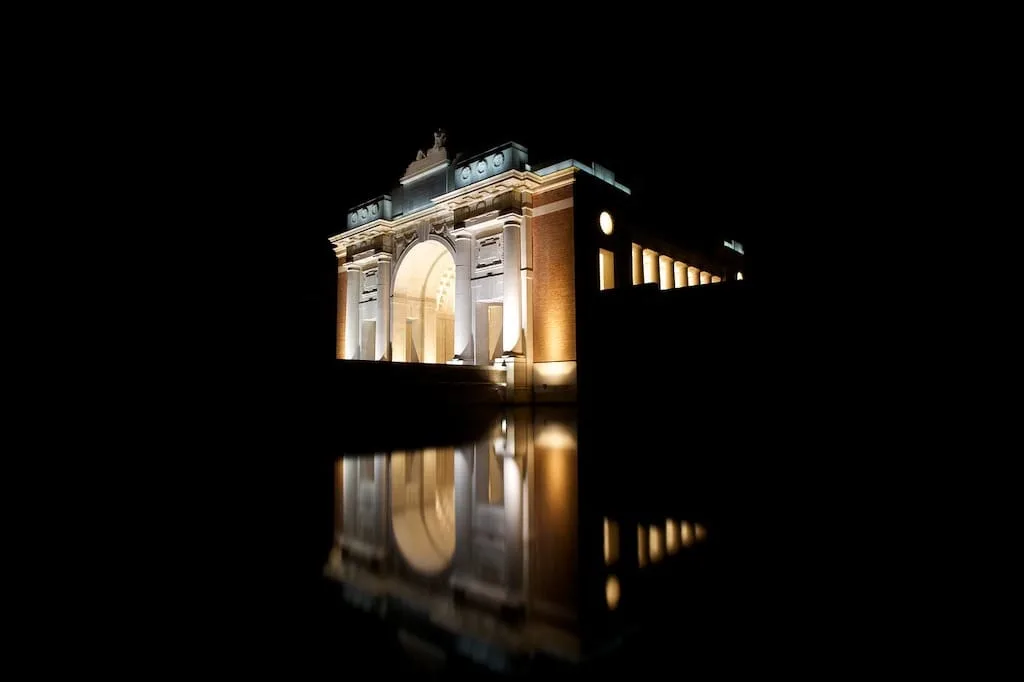
National Basilica Of The Sacred Heart
The National Basilica of the Sacred Heart in Brussels is an often-overlooked landmark in Belgium. While it does not compare in age or popularity to other Belgian landmarks, this church is well worth a visit. It is the brainchild of the Belgian king, Leopold II, who hoped to create a large, nationally-important church in Brussels.
The Basilica is, by far, the largest church in Brussels and one of the largest churches in the world. It is also one of the largest art deco buildings in the world.
Built in the early twentieth century, the Basilica of the Sacred Heart is slightly out of the way for most tourists in Brussels. Located in Koekelberg, it can be reached on foot, though the walk will take about an hour. The National Basilica can be reached by Brussels Metro, but that still requires a 20-minute walk. The easiest way to reach the church is to take the bus or tram, each of which stops right outside.
Brussels’ National Basilica of the Sacred Heart is unique among Belgian churches. It is newer and in a significantly different style from more popular landmark churches in Belgium. The Basilica is also enormous. The interior isn’t flashy. Rather, it’s somber, still, quiet, and often empty.
The highlight of visiting the church is the rotunda, which has incredible views of Brussels. For an architecturally important (and unique) landmark, a great view, and fewer tourists than other sites, the National Basilica of the Sacred Heart is an excellent landmark to visit in Belgium.
Explored by John Paul from The Hangry Backpacker
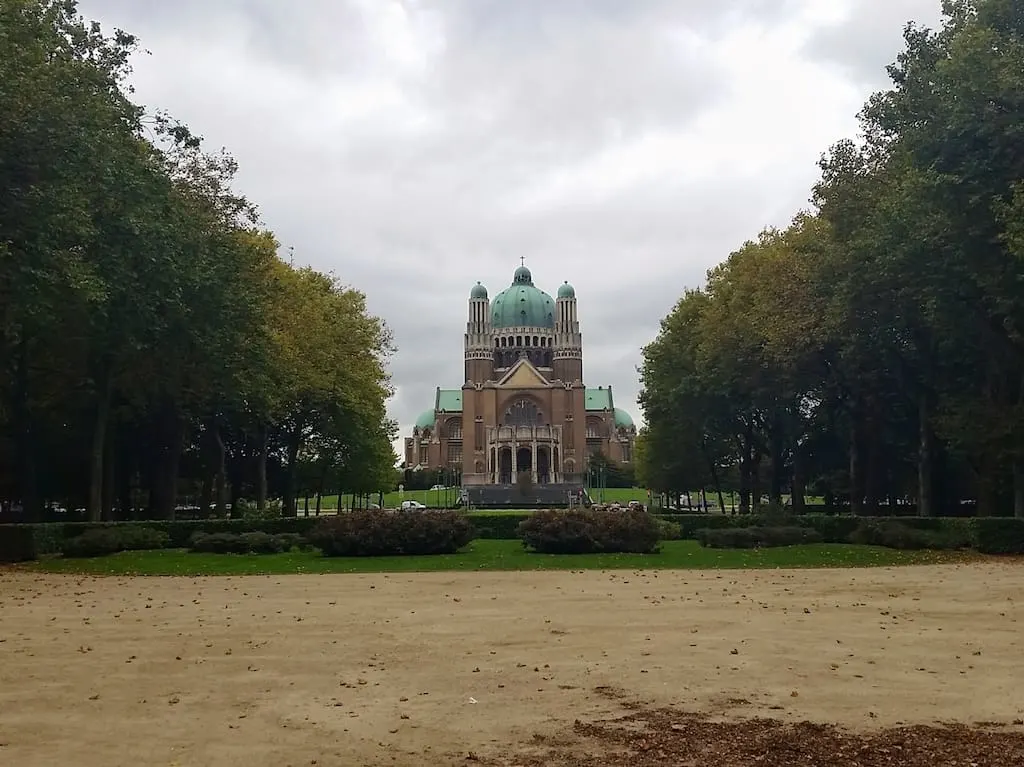
Saint Nicholas Church
This quaint city of Ghent, although not as popular as the neighboring cities of Brussel and Antwerp, is equally beautiful, if not more. The medieval and gothic style inspired infrastructure of the city is a treat to the eyes. Dotted with iconic monuments, Ghent is small but packed with history and beauty. One such famous and ancient landmark adding to the charm of the city is the St. Nicholas Church. Located centrally, this church, along with other historic landmarks, forms the magical skyline of the city center.
A prominent architectural beauty, this church has been in existence since the 1300s. This spellbinding structure, built-in Tournai blue-gray stone, was paid for by the wealthy merchants of Ghent to denote their affluence to other neighboring Flemish cities.
It is just a few steps, about 2 minutes away from the best budget-friendly hostel in Ghent. And if you are visiting Ghent just for a day, then it is a 35-40-minute train ride from Brussels, the capital of Belgium. Although, it would be advisable to spend a night or two in Ghent, for this city has more to offer and is deserving of more than just a day’s visit.
During the day, this gothic rock structure stands out and steals the show, but at night it is illuminated with lights from all around the canal and the city center. The turrets and towers of this medieval structure truly give an illusion of being in a fairytale. The church also carried the town bells up until the Belfry of Ghent was constructed next to it.
Explored by Harshi & Aman from Trot.world
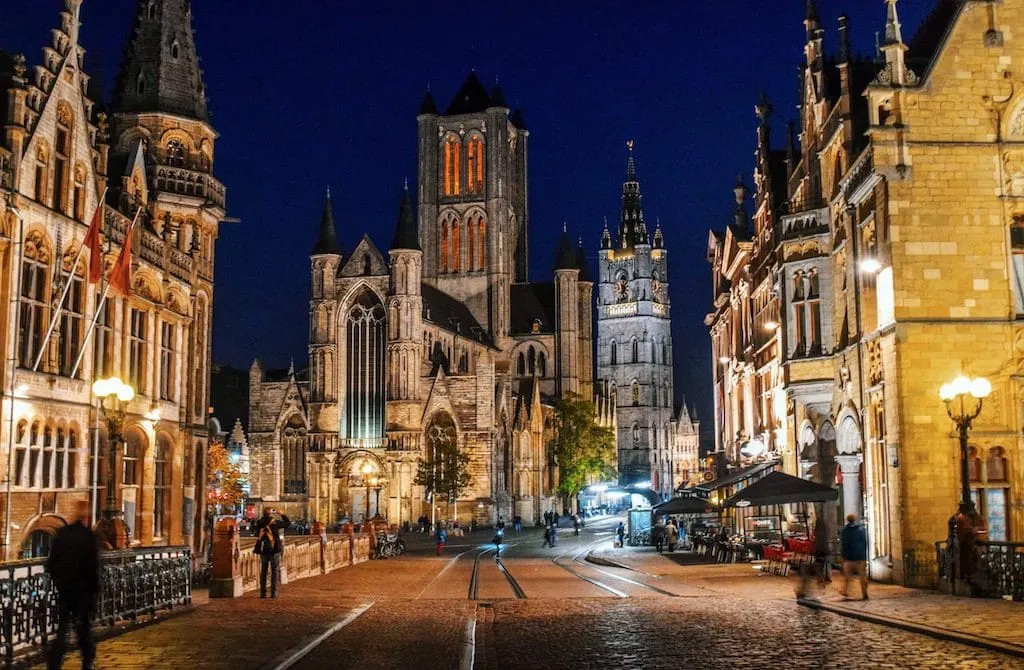
St Michael And St Gudula Cathedral
Brussels, the capital city of Belgium, is small and compact, with a unique character that comes from its French and Flemish roots. Now home to over 2 million people of diverse nationalities, this mix has added a cosmopolitan flavor to the urban atmosphere.
Most tourists come to Brussels by train, and the main station is located right in the heart of Brussels old city center, connecting to a number of main sights from the Brussels Park to the Grand Place. The Cathedral of Saint Michael and Saint Gudula is probably the first landmark in the city that you see as the Roman Catholic Church that stood for over 500 years in Brussels is right next to Central Station.
Built-in 1519, the medieval cathedral is dedicated to two patron saints: St. Michael, the advocate of the Jews, and St. Gudula, a venerated figure in Belgium. The church was built in the Gothic architectural style, having a striking resemblance to the Notre-dame in Paris or the York Minster in the UK.
It is one of the most important monuments and landmarks in Brussels because of its status and architectural beauty. First, the church is given its status as the main Catholic church in Belgium; it serves as a venue of many national Catholic events, including funerals, baptisms, and weddings of Saints and Royalties through hundreds of years. Secondly, the church is one of the finest examples of Brabantian Gothic architecture – with a strong influence from the French and the Netherlands, the church features two 114 meters tall towers that contain a 49-bell carillon by the Royal Eijsbouts bell foundry.
Don’t forget to view the two stunningly beautiful stained-glass windows on the northern and southern transepts, of which they are after the drawings of Bernard van Orley and created by Jean Haeck from Antwerp in 1537.
Explored by Kenny from Knycx Journeying
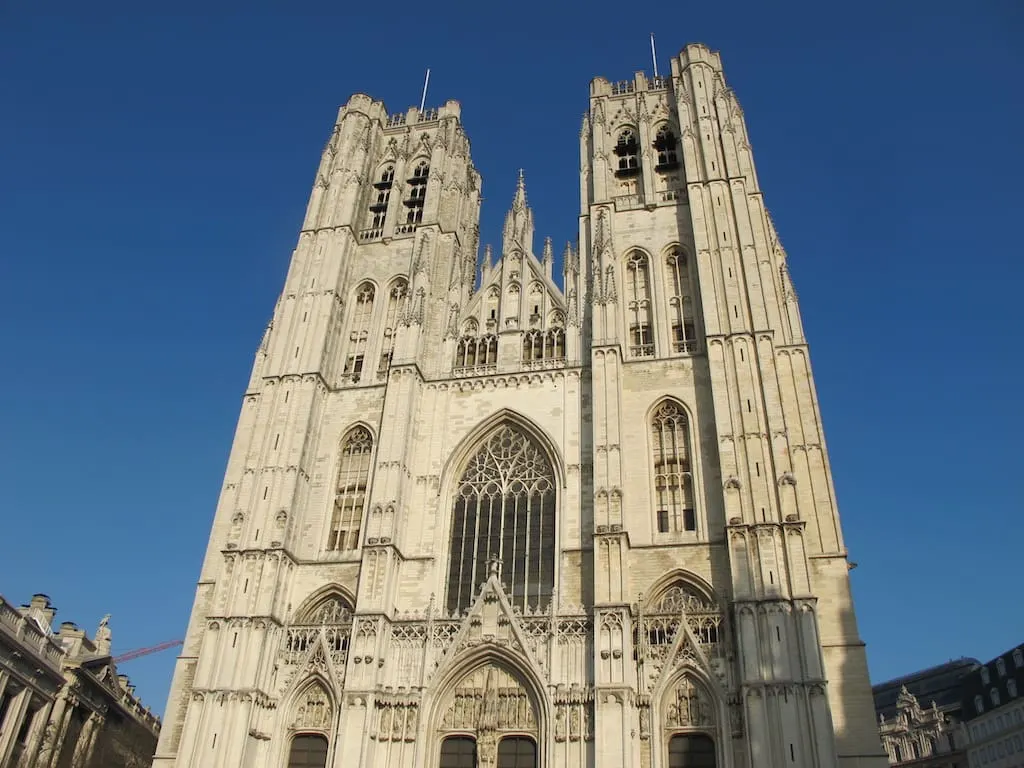
Stoclet House
The Stoclet Palace is a glorious private mansion in Brussels that has become an iconic landmark of Belgium — despite not generally being opened to the public. It was conceived by architect Josef Hoffmann for financier and prolific art lover Adolphe Stoclet between 1905 and 1911 and is established in the Woluwe-Saint-Pierre municipality of Brussels.
When Adolphe Stoclet commissioned this building from one of the Vienna Secession movement’s leading architects, he placed no artistic or financial constraints on the venture. The house and garden were finished in 1911, and their iconoclastic geometry played a pivotal role in Art Nouveau, setting the scene the style of Art Deco and the Modern Movement. Stoclet House is among the Vienna Secession’s most renowned and homogeneous structures, and stars works by Koloman Moser and Gustav Klimt, embodying the desire to create a ‘total artwork’ (Gesamtkunstwerk). Bringing attention to the artistic renaissance of European architecture, the architecture maintains a high degree of dignity, both inside and out, as it maintains much of its early furnishings and fixtures.
In terms of visiting, you are stuck looking from outside sadly as Stoclet Palace is still a private residence – rather unusual for a UNESCO World Heritage Site. Nearby Rietveld Schroder House in the Netherlands, Maison Guiette in Ghent, or the Fagus Factory in Germany are exceptional examples of how the private can be made accessible to the public. While Stoclet Palace is still stunning from the roadside, I hope one day they allow the general public to come and revel in its opulence.
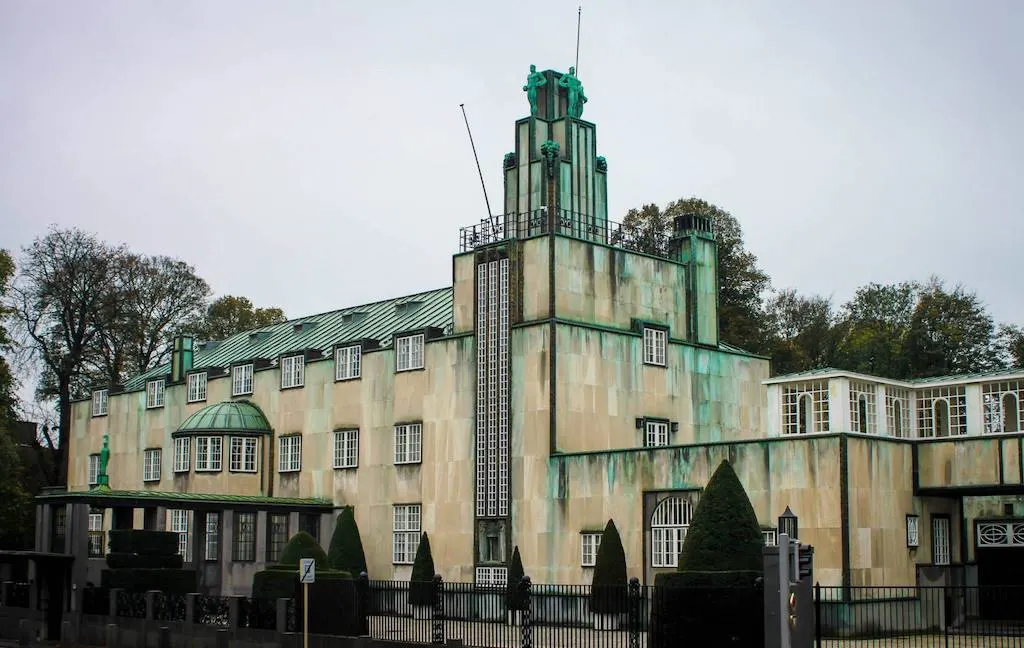
The Atomium
We love visiting Belgium, a country that offers so much, from magnificent palaces, the canals of Bruges, the WW1 memorials across Flanders Fields, and of course, the tasty chips! We definitely rate it as one of the most gay-friendly countries in the world, particularly in the capital, Brussels, home to a large LGBTQ scene, including the famous La Demence monthly party.
Of course, no visit to Brussels is complete without a visit to the Atomium, arguably one of the most unique sites we’ve ever seen! The Atomium is made up of 9 steel spheres that are connected with long hollow tubes. It’s certainly one of the most iconic landmarks of the country, if not in Europe!
It was originally constructed for the 1958 Brussels World’s Fair (Expo 58) and was designed to represent an iron crystal magnified 165 billion times to show the importance of the Atomic Age. Whilst it was only designed to last for the 1958 World Expo, it became so popular that its destruction was postponed year after year until the city’s authorities finally agreed to keep it and convert it into a permanent museum.
Whilst it doesn’t look like it, each of those spheres and respective tubes connecting them contain stairs, escalators, and exhibit halls, which you can walk through to admire! It makes for quite a surreal museum experience. The top sphere includes a restaurant that we recommend for one of the best panoramic views across Brussels.
Geeky fact, when the Atomium opened in 1958, it contained the fastest elevator known to man, reaching a maximum speed of 5 meters (16.5 feet) per second.
The Atomium is located at square de l’Atomium, 1020 Bruxelles. It isolated around 8km (5 miles) north from central Brussels, which is roughly 20 minutes by bus from Brussel Rogier to Brussel Brugmann or a 15 minutes cab ride.
Explored by Stefan Arestis from The Nomadic Boys
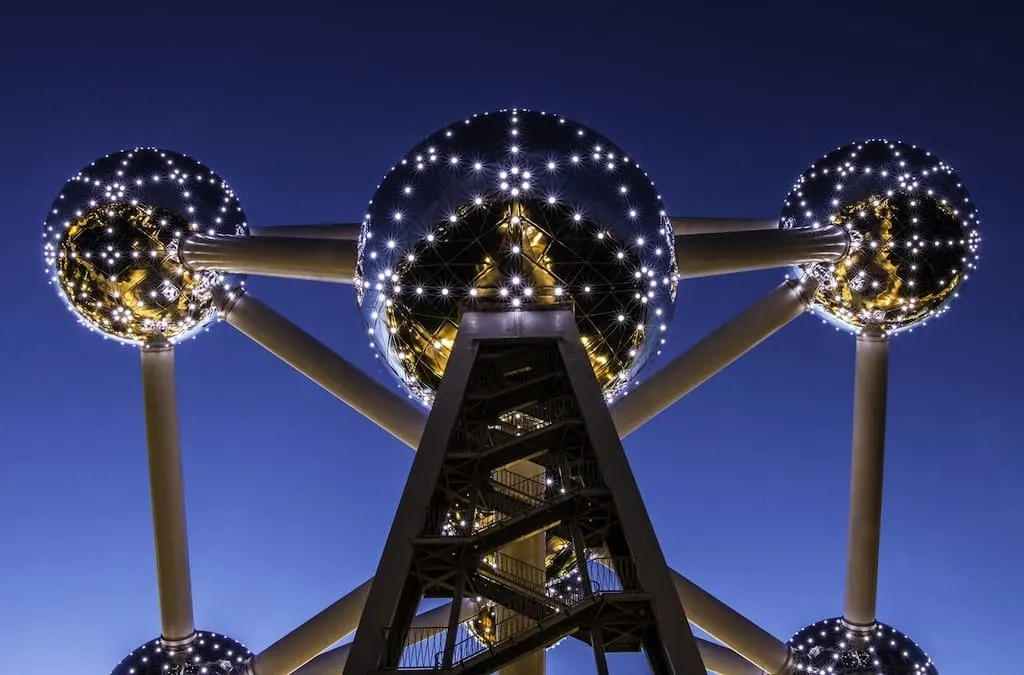
The Markt Of Bruges
Bruges’ Market (“Market Square”) is situated in the center of the Bruges and occupies an area of roughly 1 hectare. A few of the significant landmarks all-around square include the grand 12th-century Belfry and the West Flanders Provincial Court (previously the Waterhall, which was destroyed in 1787 and substituted by a classicist building which operated as a municipal court from 1850 but was reconstructed in 1887 in a neo-Gothic design after a blaze).
The Market Square has been the site of middle ages markets, fairs, contests, uprisings, and trials over the centuries – all in the shade of the mighty belfry tower. A location full of memories, the Markt is one place to visit in Belgium you won’t want to miss. The Market was entirely redesigned in 1995. Parking on the square was eliminated, and the area is now mostly traffic-free, rendering it more celebration-friendly. The restored Market was reopened in 1996, and today, the square functions as a gathering spot for the residents and the three to four million visitors who flock to the location each year.
The most impressive building is arguably the Belfry – which is a landmark of Belgium on its own. Nevertheless, there are other distinctive buildings in all four quadrants of the square, which offer a peek into the proud history of Bruges. For those who have visited Red Square in Moscow or Plaza de Espana in Seville, the feeling is similar – as is the Grand Places in Brussels or the Grote Markt of Antwerp.
Restaurants and cafes housed in historic guild houses fill the remaining spots around the square and are a delicious way to enjoy your visit. Wednesday morning is the main market day, and therefore the ideal time to visit as various stalls are set up and sell a range of fresh fruits, vegetables, herbs, products, and cheese, as well as plenty of delightful snacks.
